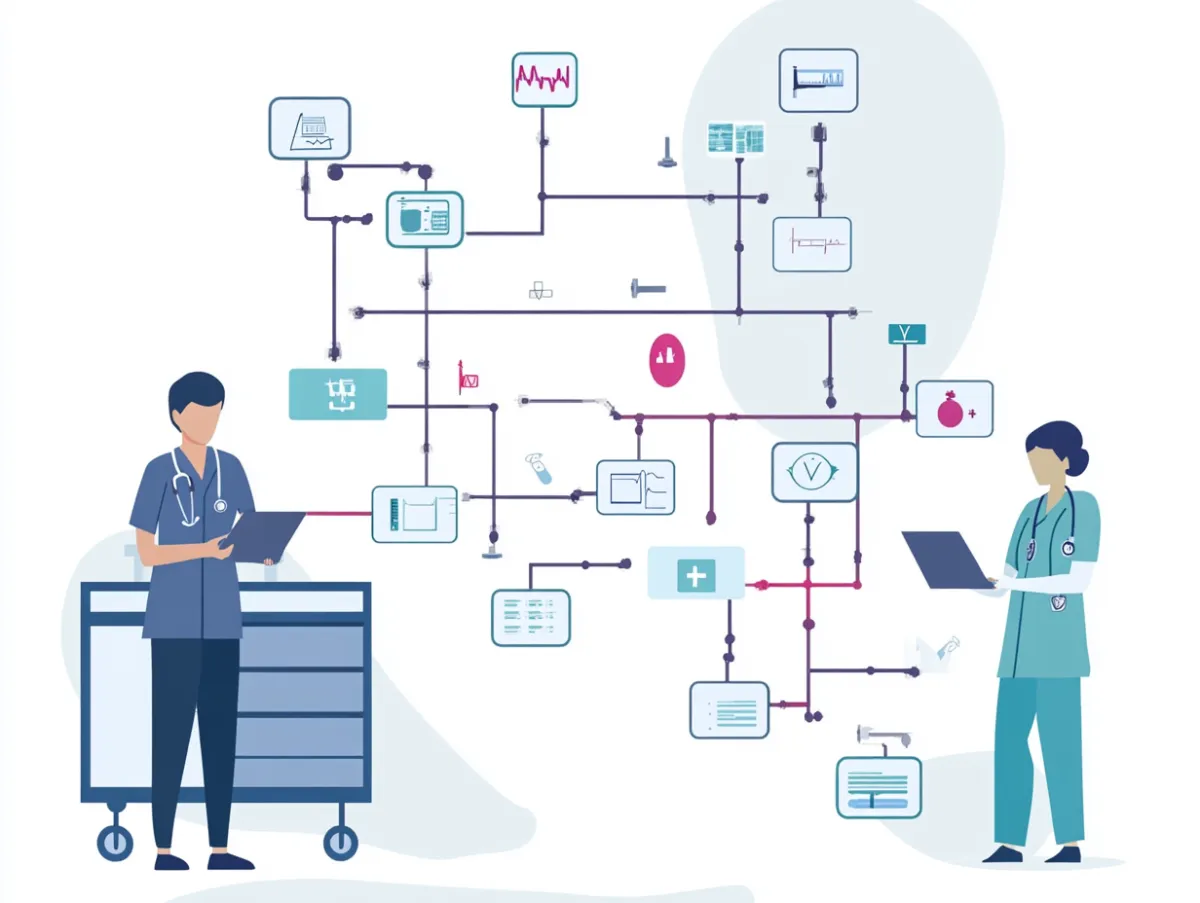

GTM Engineering, Marketing Automation & AI
By investing in marketing and automation software, you can streamline your customer acquisition process, nurture leads, and unlock hidden revenue through database re-activation. These tools can help you target the right customers, at the right time, with the right message, increasing the chances of converting them into paying customers.

Patient Flow Process: What You Need to Know
What is a patient flow process?
The patient flow process is essential to providing high-quality healthcare. It refers to the acquisition and nurture of patients as well as the movement of patients through various stages of care, ranging from initial check-in to discharge. Efficient patient flow ensures that patients receive timely medical attention, reducing wait times and enhancing overall satisfaction.
When a patient enters a healthcare facility from a referral or your marketing efforts, their journey typically starts at reception, moves through various departments like triage, diagnostics, and treatment, and culminates in discharge or transfer.
Each of these stages involves different teams and resources, and any bottleneck can lead to delays and decreased quality of care. Therefore, effective patient flow management aims to streamline these transitions.
Understanding patient acquisition and flow is vital not just for individual healthcare providers but for the entire healthcare system. An efficient patient flow process minimizes congestion, optimizes resource usage, and ensures that healthcare providers can focus on delivering excellent care rather than administrative tasks.
Implementing technology such as a patient CRM, Electronic Health Records (EHRs) and real-time tracking systems can significantly enhance patient flow. These tools assist in coordinating between departments, improving communication, and tracking patient status in real time.
Ultimately, the goal is to create a seamless journey from check-in to check-out, ensuring each patient receives the care they need promptly. By optimizing the patient flow process, healthcare facilities can acquire more patients and improve patient outcomes, elevate staff efficiency, and reduce costs, making it a crucial aspect of modern healthcare.
Key Stages of the Patient Flow Process
Navigating the patient flow process involves several crucial stages designed to ensure a smooth and efficient journey for the patient through the healthcare system. Each step plays a pivotal role in delivering high-quality care and optimizing resource utilization.
Patient Acquisition and Nurture Automation: This section of the patient workflow process focuses on the strategies and tools used to attract new patients and foster ongoing engagement and loyalty.
Patient Admission: This is the initial step where patient details are recorded, and the reason for the visit is identified. Efficient admission procedures can reduce wait times and set the tone for the patient's experience.
Triage and Assessment: In this stage, healthcare professionals evaluate the patient’s condition to determine the urgency of care required. Prioritizing patients based on their needs helps in managing critical cases more effectively.
Diagnosis and Treatment Planning: After triage, the patient undergoes diagnostic tests and assessments. Based on the results, a personalized treatment plan is developed. Streamlining these processes can speed up decision-making and improve outcomes.
Treatment and Interventions: This stage involves the execution of the treatment plan, which could include medical procedures, surgeries, or therapeutic interventions. Efficiently managing this phase helps in optimal resource allocation and reduces bottlenecks.
Patient Monitoring and Follow-Up: Post-treatment, continuous monitoring ensures that the patient is responding well to the interventions. Follow-up appointments are scheduled to track progress and address any complications early.
Discharge and Aftercare: The final stage involves discharging the patient with comprehensive instructions for at-home care and future appointments. Proper discharge planning minimizes readmissions and promotes faster recovery.
By paying close attention to each stage of the patient flow process, healthcare facilities can enhance patient satisfaction, reduce wait times, and improve overall care efficiency.
Importance of Efficient Patient Flow in Healthcare
Efficient patient flow is crucial for the overall success of healthcare systems. When patient flow is optimized, it ensures that the practice scales and patients move smoothly from one stage of care to another, ultimately enhancing the quality of care they receive.
Firstly, efficient patient acquisition and nurture promotes practice growth and quality of equipment and procedures offered. The efficient acquisition and nurturing of patients is a key driver for the growth and quality of a medical practice. Ultimately, the efficient acquisition and nurturing of patients is a virtuous cycle that fuels the growth, quality, and long-term success of a medical practice.
Secondly, efficient patient flow minimizes wait times. Patients who experience shorter wait times are generally more satisfied with their care. This boosts the reputation of healthcare facilities and can lead to higher patient retention rates. Additionally, shorter wait times can improve patient outcomes, as prompt medical attention is often crucial in emergencies.
Thirdly, optimized patient flow alleviates the burden on healthcare providers. Doctors, nurses, and other healthcare personnel can perform more effectively when they aren't overwhelmed by overcrowded waiting rooms or disorganized schedules. This results in a more focused, efficient, and happier workforce, which indirectly benefits patients through better care.
Fourthly, efficient patient flow maximizes resource utilization. Healthcare facilities are often constrained by limited resources, including staff, equipment, and beds. When patient flow is managed well, these resources can be used more effectively.
This can lead to cost savings and also allows healthcare providers to treat more patients, thereby increasing the facility's capacity.
Lastly, streamlined patient flow can enhance healthcare outcomes. Efficient processes ensure that patients receive timely diagnoses and treatments, reducing the risk of complications and readmissions. Improved outcomes benefit not just the patient but also the healthcare system by reducing the long-term costs of care.
Optimizing patient flow has a multidimensional impact: it attracts quality patients and enhances patient experience, boosts staff morale, maximizes resource efficiency, and improves health outcomes. For these reasons, efficient patient flow is a vital component in delivering high-quality healthcare.
Benefits of Optimized Patient Flow
Optimizing patient flow is a game changer for healthcare facilities. It streamlines operations, minimizes bottlenecks, and enhances the overall patient experience.
One of the significant benefits is reduced waiting times. When patient flow is well-managed, individuals spend less time in waiting rooms, which leads to higher patient satisfaction and better reviews.
Improved patient flow also translates to more efficient use of hospital resources. For example, operating rooms and diagnostic tools are utilized more effectively, reducing idle times and increasing the number of patients who can be treated.
This efficient resource allocation can also lead to cost savings for the facility, as fewer staff hours are wasted in handling unnecessary delays.
Another critical advantage is the enhancement of patient care quality. With streamlined processes, medical staff have more time to focus on patient care rather than administrative tasks. This reduces the likelihood of errors and ensures that patients receive timely and appropriate medical attention.
Optimized patient flow also positively impacts the morale of healthcare workers. When staff members operate in a system that works smoothly, they experience less stress, better job satisfaction, and increased productivity. Happier staff often translates into better care for patients, creating a win-win situation.
Finally, a well-optimized patient flow can improve the facility’s reputation. Hospitals and clinics known for their efficiency and high-quality care are more likely to attract new patients and retain existing ones, bolstering their standing in a competitive healthcare market.
Common Challenges and Solutions in Managing Patient Flow
Managing patient flow in healthcare settings can often feel like solving a complex puzzle. Common challenges include overcrowded waiting rooms, long waiting times, and scheduling conflicts. These issues can cause patients to feel frustrated, overwhelmed, and dissatisfied with their care.
One primary challenge is the lack of coordinated communication among staff members. When the front desk, nurses, and doctors aren't on the same page, it can lead to bottlenecks and delays, automating some of these workflows can alleviate bottlenecks and free up staff time to attend to urgents issues.
This is where electronic health records (EHR) systems come into play. An EHR system facilitates better communication and ensures everyone has access to up-to-date patient information.
Another hurdle is the overbooking or underutilization of medical staff and resources, it's here where a patients CRM can streamline communication with effective automation and integration. To address this, healthcare facilities can use predictive analytics. By analyzing historical data, these systems can forecast patient volumes and help with more efficient scheduling.
Additionally, inefficient discharge processes can significantly slow down patient flow. Hospitals can implement streamlined discharge planning, ensuring that all necessary steps are taken well in advance. This includes preparing discharge papers, ensuring medication readiness, and setting up follow-up appointments.
Lastly, the handling of emergency cases can disrupt the flow. Establishing a fast-track system for less critical cases can ease the burden on emergency departments. Triage protocols can also help, ensuring that each patient receives the appropriate level of care promptly.
While managing patient flow comes with its challenges, employing technology, better communication, a patient nurture CRM and efficient planning can lead to significant improvements. Addressing these issues not only enhances patient satisfaction but also boosts the overall efficiency of healthcare facilities.
Future Trends in Patient Flow Management
The landscape of patient flow management is set for transformative changes fueled by technology and evolving healthcare practices. One of the most promising trends is the integration of Artificial Intelligence (AI) and Machine Learning (ML) and patient flow CRM and nurture automation.
These technologies can predict patient admission rates, optimize staffing, and streamline scheduling, thereby reducing bottlenecks. For instance, predictive analytics can forecast busy periods, allowing hospitals to better allocate resources.
Telemedicine is another game-changer. By enabling remote consultations, telemedicine can alleviate in-hospital congestion and reduce the pressure on emergency departments.
With wearable tech and remote monitoring systems, patients can receive timely care without stepping into a medical facility, thereby freeing up valuable in-hospital resources.
Electronic Health Records (EHR) are continually improving and becoming more interoperable. This advancement allows for faster access to patient histories, making it easier to make quick, informed decisions.
Cloud-based EHR systems also facilitate smoother transitions as patients move between departments or even different healthcare facilities.
Robotics and automation are revolutionizing administrative tasks. Automated patient check-in systems and robotic process automation for medical billing and inventory management can significantly cut down waiting times and administrative errors.
Lastly, the patient-centric approach is gaining traction. This involves the use of apps and online portals to keep patients informed and engaged in their own care.
When patients have streamlined access to their treatment plans and appointments, it improves their experience and contributes to efficient patient flow.
By capitalizing on these emerging trends, healthcare providers can create a more efficient, patient-friendly environment, ultimately leading to better patient outcomes and enhanced satisfaction.
Transform Your Business with Smart Marketing Automation Software...
Konig Digital, LLC
Address: 7903 Cole Ave, Takoma Park, MD 20912, United States
Email: [email protected]
Phone No: +1 (240) 202-2609
Hours:
Weekdays – 8 AM to 5 PM
Weekends- OFF

2025 All rights Reserved | Sitemap





